Recommended Stories
New Delhi: With demonetisation channelising enormous amount of savings into banks for productive use, consolidating financial data on businesses can provide banks with the necessary information to assess creditworthiness of borrowers, industry chamber CII said on Sunday.
"A digital infrastructure providing comprehensive data to financial institutions would help smoothen access to credit from the borrower's angle and assessment of credit worthiness from the lender's side. It would supply identification, financial information, credit information and other information related to governance of a company," Confederation of Indian Industry Director General Chandrajit Banerjee said in a statement here.
"This can also enable banks to devise a tailored interest rate policy by differentiating borrowers," he said.
"The data is present in the system, though the ownership is with different government bodies. It is possible to thread these data accesses together for a well-connected digital infrastructure that can enable banks to lend to credible borrowers. Naturally, this is also a mechanism to avoid creation of NPAs, or bad loans, at a later date," he added.
CII has suggested that abundant data on small and medium enterprises (SMEs) and corporates through various sources can be made available to the banks and other lending institutions.
The banks may choose to offer loans at varied interest rates depending on the strength of the data of the customer, it added.
The industry chamber proposed a three-step process to make data available for digital infrastructure.
"To start with, the data needs to be made available digitally by strengthening the existing digital data sources by expanding Central Repository of Information on Large Credit (CRILC) coverage to include mutual funds (MF), financial institutions (FIs), and external Commercial Borrowings (ECBs)," CII said.
The second step suggested is to design the architecture for data sharing by reaching an agreement on mode of data sharing, such as the Application Programme Interface (API) integration of each institution directly with banks or a central integrating agency to co-ordinate and share consolidated information.
The statement said the final step would be to build supporting infrastructure through APIs, build supporting consent and authentication architecture and cyber security architecture to ensure data security.
"A robust credit data infrastructure will allow banks to better analyse the financial data by way of triangulation of information and also provide greater industry insights. This would also lower costs and potentially ease the flow of credit to MSME segment" said Shikha Sharma, Chairperson, CII National Committee on Banking and CEO, Axis Bank.













